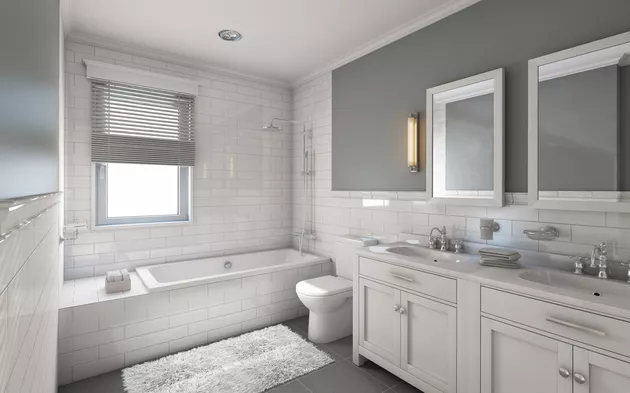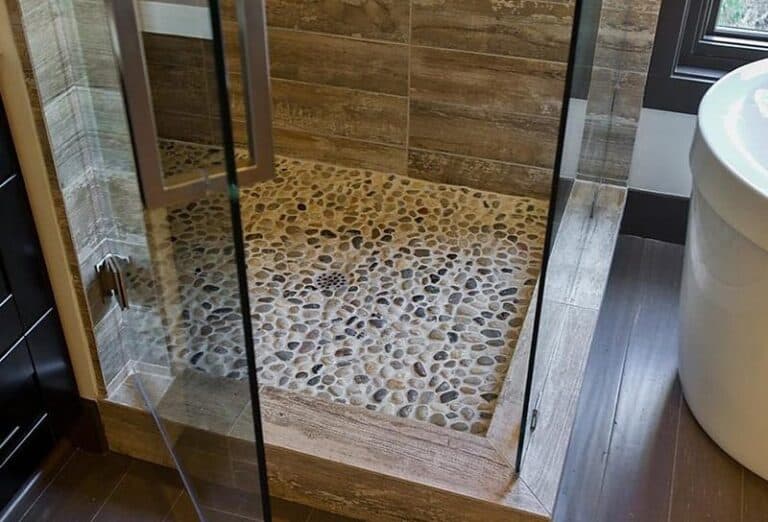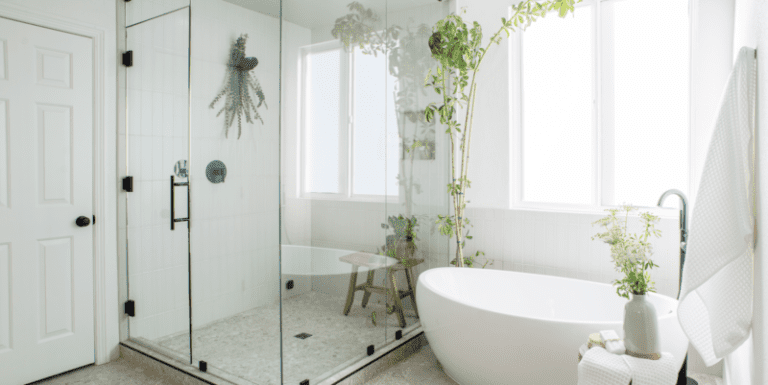Alcove vs. Drop-In Tub: Which is Right For You?

Nothing is quite as relaxing as a nice hot bath. It can calm you after a hectic work day. Sooth sore muscles after a strenuous session at the gym. A bath has the power to wash away our stress and worries, if only for a while. Whether you use bubbles, bombs, or both, once you’ve immersed yourself in the luxurious water, all is right with the world.
But before you can reach that point, you must choose a tub that works for both you and your space. Below we will discuss the differences between alcoves and drop in tubs. Their features, drawbacks, and which one may be right for you and your space.
Alcove vs. Drop In Tub: What’s The Difference And Which One Is Best For Me?
Alcove Tub
An alcove tub is basically the standard tub that has traditionally been installed in most bathrooms. The alcove tub is fitted into a 3-wall enclosure that is made specifically for this type of tub. The 3 sides of this tub are unfinished and each sits against a wall. The 4th side of the alcove tub is called the apron and is usually finished with a gloss or matte sheen. These tubs come in a variety of materials, like fiberglass, acrylic, and porcelain. Features of the alcove tub include:
- space saving
- easy to maintain
- Good for people with mobility issues
- can be fitted with jets
- can be fitted with a shower attachment
- shower curtain or door for privacy
- less expensive than drop in tubs
Drop In Tubs
The drop in style, are tubs that are dropped into an existing structure or deck. There are no finished sides as all but the top rim of the tub are enclosed in the deck. The drop in tub does not need to be up against a wall. It can be anywhere in the space, from up against a wall to the center of the room. Drop-in tubs are usually made from porcelain, ceramic, or fiberglass. Some features include:
- often oversized for ample bathing space and comfort
- greater freedom with fixtures and faucets
- versatility with decor and design
- easier to keep water inside
- add on whirlpool and jets
There are quite a few factors to consider
1. Price
For the most part, alcove tubs are less expensive than drop in tubs. So, if you’re on a budget, an alcove tub may be right for you.
2. Size of the space
If you have a smaller bathroom, you may want to go with an alcove tub. However, a drop in is great for oversized spaces. As it can be the centerpiece for a whole design concept.
3. Ease of use
An alcove tub is easy to get in and out of. Whereas a drop in is easy to get into, it can be a bit tricky to get out of.
4. Versatility
An alcove tub can only be used in an enclosed three-walled space. A drop in can be used anywhere in space. You also have options with decking, design and storage space that you don’t get with alcove tubs.
5. Depth and size
Generally, drop in tubs are larger and have a deeper water level than alcove tubs.
6. Cleaning
While neither is terribly difficult to clean, the drop in tub is a bit easier to tidy up. They also do a better job at keeping water in the tub and off the floor.
So which one is right for you is really a matter of your personal style, space constraints, budget, and agility. Both tub styles are functional and attractive and get the job done equally as well.
What Materials Are Used For Tubs?
Once you’ve decided on whether you’re going the alcove or drop in route, then it’s time to choose what type of material you want for your tub. Here are 5 of the most popular materials used, regardless of if you choose a drop in or an alcove.
1. Acrylic
One of the most popular choices because of its versatility, low cost, and durability. Acrylic is also available in a wide range of color options. It’s easy to install, non porous, and has an easy to repair surface. One drawback is that it will easily scratch if cleaned with abrasive substances.
2. Fiberglass
The most affordable of tub materials, fiberglass, is easy to install, easy to clean, lightweight, and has a surface that can be repaired and is great for a tub shower combo. However, the surface can crack and the finish fades.
3. Porcelain Enameled Steel
This material is a common and affordable option for tubs. Porcelain is easy to clean and durable. Though it’s easy to chip and quick to lose heat.
4. Cast Polymor
This material is a mix of natural stone and polymeric materials. This is a good choice as scratches can easily be buffed out, and it’s stain and mildew resistant. It’s affordable, though it tends to be brittle.
5. Cast Iron
This is an extremely heavy material and is quite durable. It’s also the most expensive tub material, but it’s built to last. This is a great option all around. The only drawback is, that due to its weight, some structural reinforcement of floors and walls may need to be done.
What Are Some Unique Features You Can Get With A Bathtub?
Whether you choose an alcove or a drop in tub, there a many delightful features you can add on to make your soaking experience even more enjoyable.
1. Whirlpool
This is a fun and functional feature. The jets have in-line heaters, so not only do you get relaxing bubbles, but also a constant flow of warm water. So there’s no need to change out the water when it starts to cool. Many whirlpools also have head and foot rests that give massages as well.
2. Music
No more having to take your earbuds and phone into the bathroom. You can get a tub with speakers attached to the side. The speakers can also send sound through the water and you can feel the beat vibrate off your skin.
3. Chromatherapy
We all know that lighting plays a big part in creating calm and ambiance, so why should the tub be any different? You can get your tub equipped with LED lights. The color can be changed depending on your mood.
What Are Some Things To Make Tub Time Even More Enjoyable?
Being in a quiet space, surrounded by warm water may be quite enough for some of us. But if you’re looking to make your bath experience even more relaxing, here are a few suggestions.
1. Padded pillow
Nothing is better than being able to put your head back, close your eyes, and let the bubbles take you away.
2. Cup holder
This inexpensive extravagance will usually suction the wall. Whether it’s for tea, wine, water, or coffee, a cup holder is a small price to pay for the knowledge your beverage won’t fall in the water with you.
3. Drain cover
So you can fill it all the way up.
4. Bathtub caddy
This is a must have if your bath is going to be the highlight of your evening. A good caddy that securely holds your phone or tablet so you can watch a movie, check your social, or read some gossip. It will also keep any other essentials within reach.
5. Microfiber turban and towel
These will make getting out of the tub a little easier. The softness will envelope you and the technology will dry you quickly.
6. Fuzzy bath mat
So your feet aren’t shocked when getting out of the tub.
7. Bath bombs
The aromatic fizzy balls are fun and therapeutic.
8. Waterproof notepad
Because you never know when the next big idea may come from, or maybe just remind yourself to pick up some bread.
9. Candles
Candles are an iconic bathtime staple. Providing both ambiance and aroma therapy.
10. Bundles of herbs
Whether it’s lavender, eucalyptus, or safe, dried herbs add a subtle touch of nature to your bath.
A Few Interesting Facts Involving Bathtubs?
- John Kohler invented the personal bathtub in 1883. He took a horse trough, attached some decorative feet, and covered it in enamel.
- A bath uses less water than a shower.
- About 365 people drown in bathtubs each year.
- On the Titanic, over 700 third class passengers had to share two tubs.
- If you don’t have an underground shelter, it is advised that you hide in your tub during a tornado.
You can also read:






